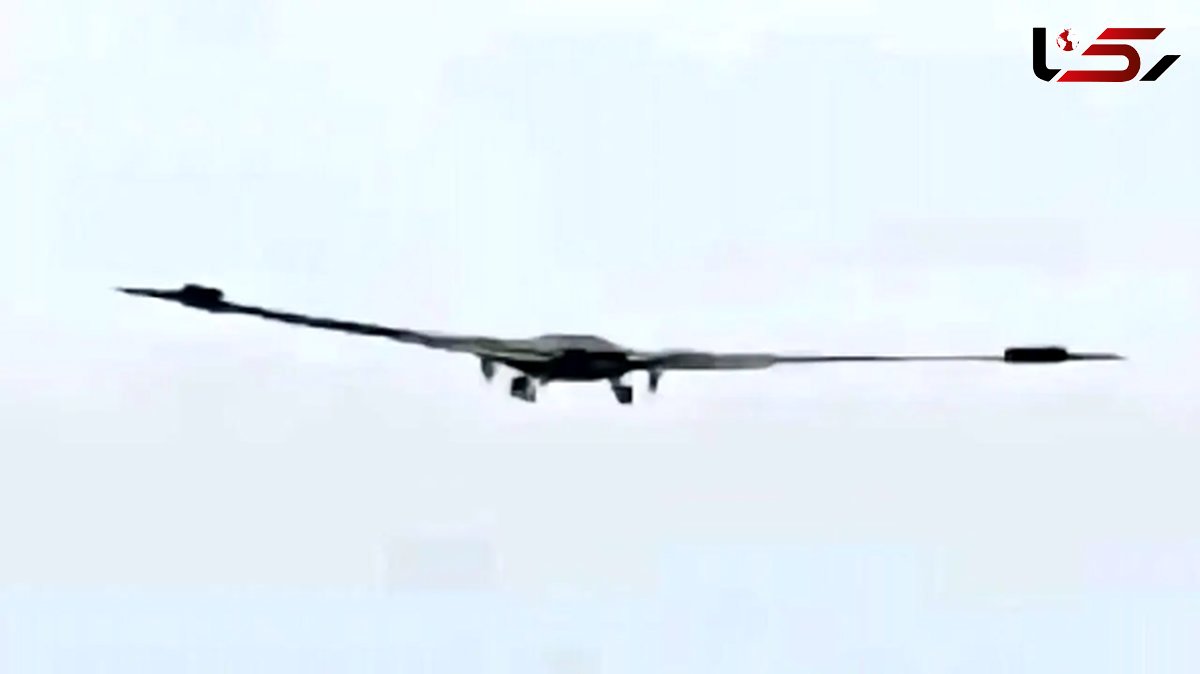Chinese Version of the B-2 Bomber!
Mystery of a Giant, Unidentified Drone in Chinese Skies
Rokna Political Desk: A massive, unidentified drone with a flying-wing design has been sighted in the skies over China. This mysterious aircraft, which may be the WZ-X drone, was likely tested at a secret base in Xinjiang province and possesses features similar to the B-2 bomber.

Recently, an image emerged showing a very large, stealthy flying-wing aircraft in Chinese airspace. The identity of this aircraft has not been definitively confirmed, but it shares many characteristics with the large drone identified in satellite images earlier this summer.
The newly released image shows the drone from the rear, with its landing gear deployed, main wheel doors open, and split trailing-edge flaps similar to those of the B-2 bomber, all consistent with takeoff or landing configurations.
From this angle, the blended wing-body structure includes a broad central section with a completely flat upper surface. The image shows no cockpit, although its presence cannot be entirely ruled out. The shape of the central section also suggests the aircraft is likely twin-engine, with narrow, slit-like exhausts, though the image quality prevents precise detail identification.
Could the Unidentified Drone Be the WZ-X?
Although not definitive, it is possible that this unidentified aircraft is the same drone seen earlier this year in satellite images from a secret Chinese testing base in Xinjiang. Satellite imagery from May 14, 2025, indicated a wingspan of approximately 52 meters, nearly equal to the 52.4-meter wingspan of the U.S. B-2 Spirit bomber. Since these images were released, some observers have temporarily referred to this drone as the WZ-X.
Both the new aircraft and the drone observed in May have long, slender wings, longer than those of the stealth flying-wing CH-7 drone. The CH-7 has a deeper central fuselage, whereas the central section of the newly sighted drone appears flatter. The CH-7 is also significantly smaller than the WZ-X. Nevertheless, design changes to the CH-7 cannot rule out the development of a new variant.
Two probable WZ-X features are not clearly visible in the new image: first, a dome-like structure on top of the central fuselage, and second, potential small angled vertical fins for stability. The drone may have retractable fins, but shadows and image distortion prevent certainty.
Interestingly, both this new drone and the WZ-X share similarities with a flying-wing aircraft observed over the Philippines in 2021. Regardless of this potential connection, the size and visual characteristics suggest the new aircraft belongs to the same class, though exact dimensions remain undetermined; comparisons of landing gear and fuselage indicate its very large size. China is currently developing a range of stealth flying-wing drones of varying sizes, with the WZ-X being the largest to date.

Based on observations, this aircraft is likely a high-altitude, long-endurance (HALE) stealth drone, similar to the U.S. RQ-180, with extremely elongated wings designed for sustained long-duration flights at high altitudes. The central section, although shallow, is wide and likely provides significant volume for sensor systems. Its primary mission is probably wide-area reconnaissance and surveillance rather than offensive operations, while also accommodating beyond-line-of-sight communication systems.
Release of Images at a Key Moment
The timing of the image release is noteworthy. In recent weeks, multiple images from China have leaked, showing new fighters, drones, ground systems, missiles, and naval equipment, mostly related to the large military parade on September 3, marking the 80th anniversary of China’s victory over Japan in World War II.
It remains unclear whether this unidentified drone will participate in the parade, but the timing of the image release seems deliberate. Similar images of new aircraft have previously emerged during test flights at factory airfields.
Despite the many similarities between this aircraft and the WZ-X, confirming the connection will require more time. What is clear is China’s determination to develop large stealth drones as part of its future air combat ecosystem. In addition to these drones, China is pursuing other key projects, including the three-engine J-36 fighter, the J-XDS fighter, several tactical manned jets, and a growing fleet of loyal companion drones for cooperative operations.
Additionally, the stealth H-20 bomber, which has yet to be unveiled and is likely a flying-wing design, remains one of these secretive projects. Overall, the release of this image highlights the accelerating development of China’s next-generation air combat programs, likely including multiple large, stealthy, flying-wing designs with high endurance capabilities.
Send Comments